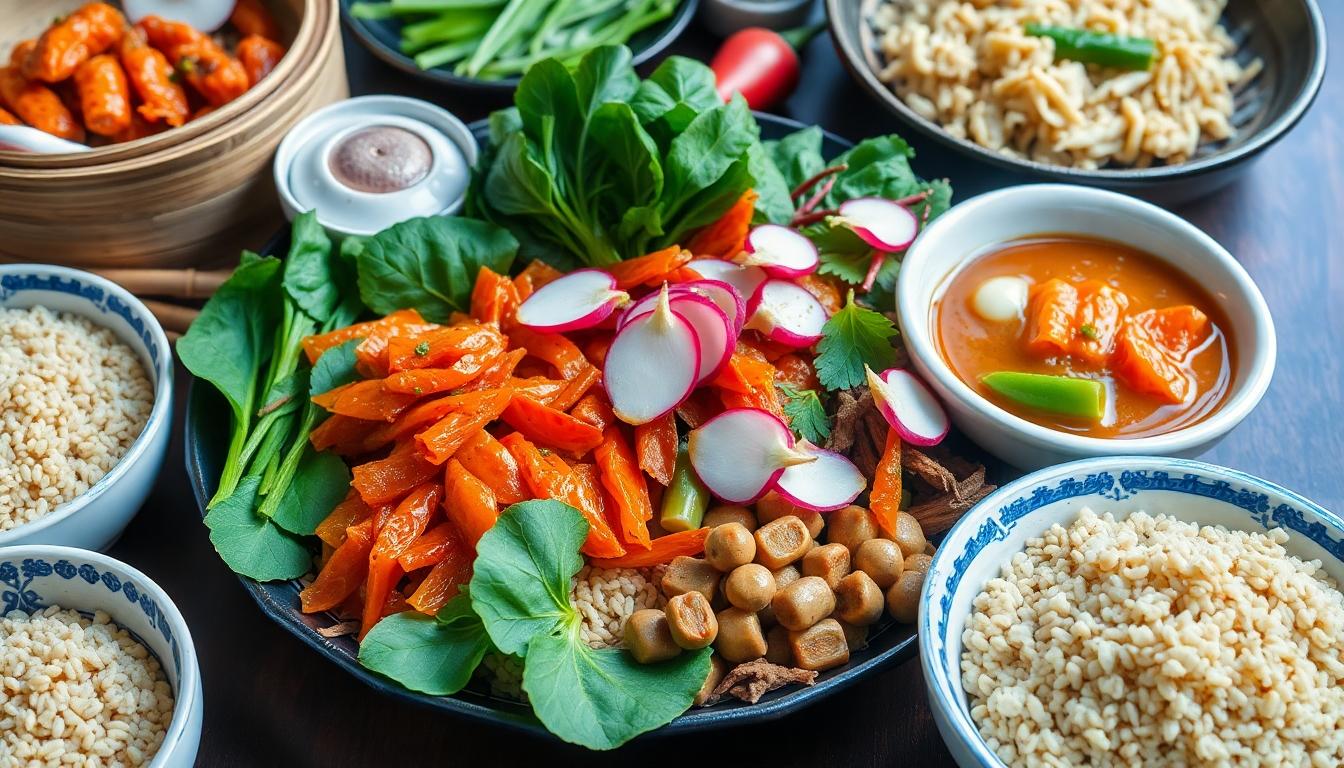Table of Contents
ToggleKorean cuisine isn’t just a feast for the senses; it’s a treasure trove of healthy delights waiting to be discovered. Imagine biting into a spicy kimchi that’s not only packed with flavor but also brimming with probiotics. Or picture a sizzling bowl of bibimbap, colorful and loaded with fresh veggies, that makes your taste buds dance while nourishing your body.
Overview of Healthy Korean Cuisine
Korean cuisine showcases a remarkable balance of flavors, nutrition, and vibrant colors. Rich in vegetables, legumes, and fermented foods, it offers numerous health benefits. Dishes like kimchi contain probiotics, enhancing gut health while providing essential vitamins. Additionally, bibimbap serves as a nutrition powerhouse, featuring a variety of fresh vegetables, lean proteins, and a flavorful sauce.
Fermented foods play a crucial role in Korean cooking. These foods contribute to overall health by promoting healthy digestion and boosting the immune system. Not only are they tasty, but they also support metabolic health. Popular choices include doenjang and gochujang, both packed with antioxidants and health-promoting properties.
The use of whole grains further enhances the nutritional value of meals. Common grains such as brown rice and barley replace refined grains, providing fiber and essential nutrients. Many Korean recipes emphasize plant-based ingredients, aligning with dietary recommendations for maintaining health.
Balancing flavors is key in Korean cuisine. The combination of sweet, salty, sour, and spicy elements elevates the cooking experience. Ingredients like garlic, ginger, and sesame oil not only impart depth of flavor but also offer health benefits, including anti-inflammatory and antioxidant properties.
Overall, healthy Korean recipes emphasize fresh, seasonal ingredients. These recipes encourage home cooking, which cultivates a more health-conscious lifestyle. With a focus on wholesome ingredients and traditional cooking methods, Korean cuisine remains a delicious and nourishing choice.
Nutritional Benefits of Korean Ingredients

Korean cuisine offers numerous health benefits through its diverse ingredients and cooking techniques. This section highlights key components that contribute to overall wellness.
Key Ingredients in Healthy Korean Recipes
Kimchi stands out for its high probiotic content, promoting gut health. Fresh vegetables, such as spinach and radishes, deliver essential vitamins and minerals. Whole grains like brown rice and barley not only add fiber but also provide sustained energy. Legumes, including mung beans and soybeans, contribute plant-based protein and antioxidants. Gochujang, a fermented chili paste, contains health-boosting properties along with a unique flavor. Finally, sesame oil offers healthy fats and can enhance heart health.
Traditional Korean Cooking Techniques
Steaming is a common method that preserves nutrients while ensuring flavorful dishes. Stir-frying enables quick cooking that enhances the taste of vegetables without excessive oil. Fermentation, a cornerstone of Korean cooking, enriches foods with probiotics and complex flavors. Braising brings together ingredients gently, allowing natural flavors to meld together seamlessly. Grilling, often seen in dishes like bulgogi, adds depth and smokiness while retaining nutrients. These techniques collectively emphasize health and flavor, creating a balanced approach to cooking.
Popular Healthy Korean Recipes
Korean cuisine offers a variety of healthy recipes packed with nutrition and flavor. Here are some popular options.
Kimchi Variations for Health Benefits
Kimchi, a staple in Korean cooking, features fermented vegetables rich in probiotics. Napa cabbage and radishes enhance gut health and digestion. Variations include beet kimchi, which adds antioxidants and vitamins, and cucumber kimchi, known for its refreshing crunch and hydration. Mixing in garlic and ginger increases antimicrobial properties, boosting overall immunity. This dish is low in calories while being high in flavor, making it an ideal choice for health-conscious individuals.
Bibimbap: A Balanced Meal Bowl
Bibimbap serves as a colorful and balanced meal featuring rice topped with assorted vegetables. Ingredients like spinach, carrots, and mushrooms provide a range of essential vitamins and minerals. Tofu or lean meats offer protein, enhancing the dish’s nutritional value. The addition of a fried egg contributes healthy fats and richness. Gochujang, a fermented chili paste, adds flavor while supporting metabolism. Enjoying bibimbap ensures a satisfying and nourishing dining experience.
Low-Calorie Korean BBQ Options
Korean BBQ can be both flavorful and low in calories when prepared with lean cuts and plenty of vegetables. Galbi, marinated beef short ribs, can be made healthier by using tender cuts with minimal fat. Grilled vegetables like zucchini and bell peppers provide added nutrients without many calories. A dipping sauce of sesame oil and garlic complements various meats and enhances flavor profiles. Incorporating lettuce wraps creates a fun, fresh alternative to buns, allowing people to enjoy BBQ without excessive calories.
Tips for Cooking Healthy Korean Dishes at Home
Incorporating whole grains enhances the nutritional profile of meals. Opting for brown rice or barley instead of white rice creates a fiber-rich base. Selecting fresh vegetables not only adds vibrant colors but also maximizes vitamins and minerals.
Utilizing fermented ingredients boosts gut health. Adding kimchi or doenjang to dishes provides probiotics beneficial for digestion. Embracing a variety of vegetables elevates flavors and ensures a range of nutrients.
Prioritizing lean proteins contributes to balanced meals. Using tofu, chicken, or fish as primary protein sources maximizes health benefits and minimizes saturated fats. Incorporating legumes into recipes adds plant-based protein and antioxidants.
Experimenting with cooking techniques preserves nutrients. Steaming vegetables maintains their vitamins while enhancing their natural flavors. Stir-frying with minimal oil promotes a healthier dish without sacrificing taste.
Balancing flavors creates a more enjoyable dining experience. Combining sweet, salty, sour, and spicy elements results in a harmonious taste. Including garlic, ginger, and sesame oil adds depth while providing health benefits.
Making mindful ingredient choices is essential. Reducing the amount of sugar and sodium in marinades or sauces leads to healthier results. Using homemade versions of gochujang and other sauces allows for better control over ingredient quality.
Employing creative serving methods enhances presentation and enjoyment. Wrapping grilled meats and vegetables in lettuce makes for a fresh, low-calorie meal option. Presenting dishes in colorful bowls encourages aesthetic appeal while keeping nutrition in focus.
Embracing healthy Korean recipes not only enhances meals but also supports a balanced lifestyle. The vibrant flavors and nutrient-rich ingredients found in dishes like kimchi and bibimbap make it easy to enjoy delicious food while prioritizing wellness. By incorporating whole grains fresh vegetables and fermented staples into daily cooking, anyone can create satisfying meals that nourish the body and delight the senses.
Experimenting with traditional techniques and mindful ingredient choices allows for endless culinary creativity. Whether it’s enjoying a colorful bibimbap or savoring grilled meats wrapped in lettuce, these recipes offer a delightful way to stay healthy. Adopting these practices fosters a deeper appreciation for Korean cuisine and its numerous health benefits, making it a rewarding addition to any diet.





